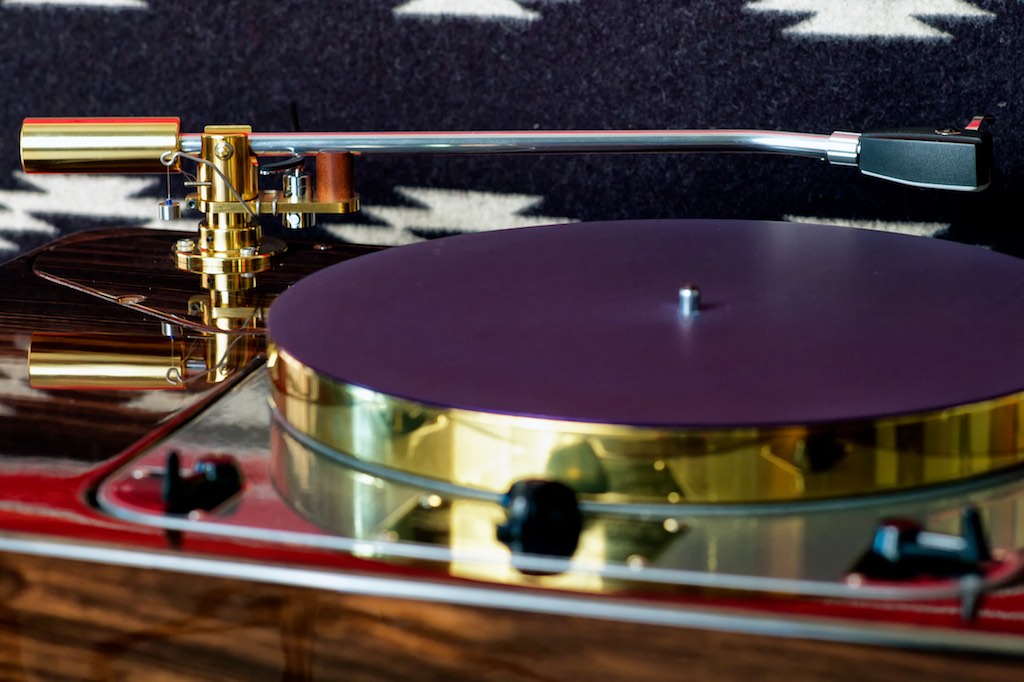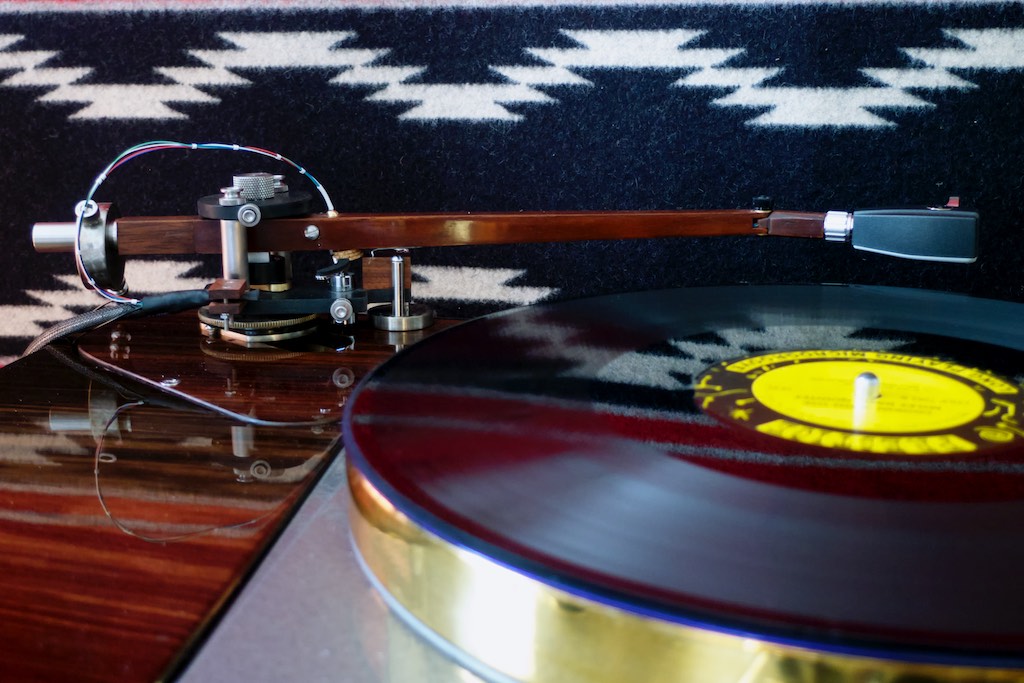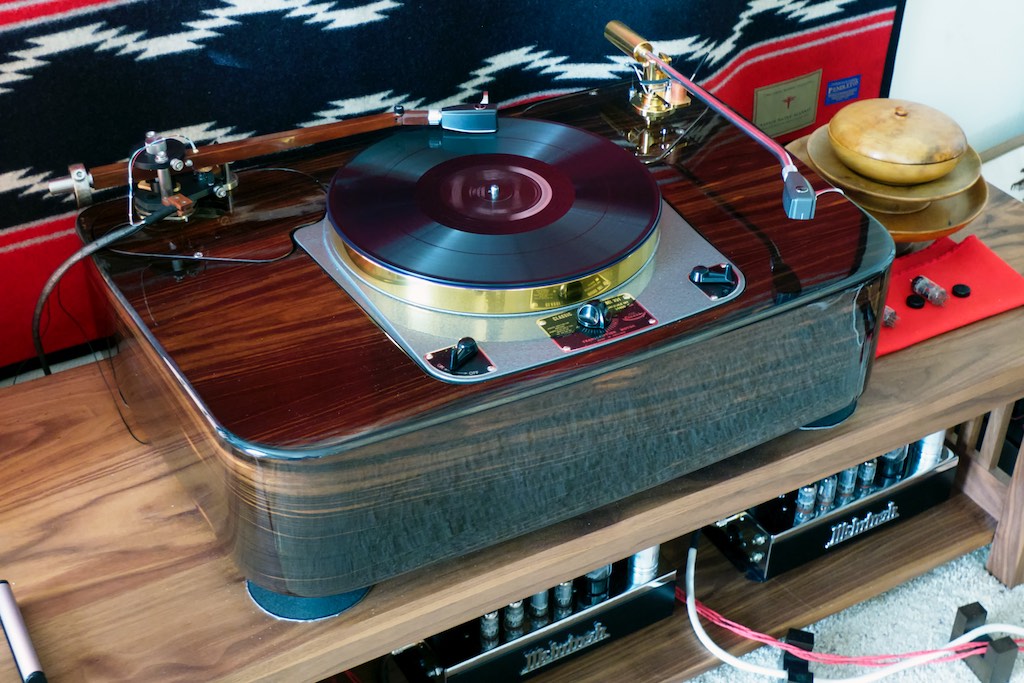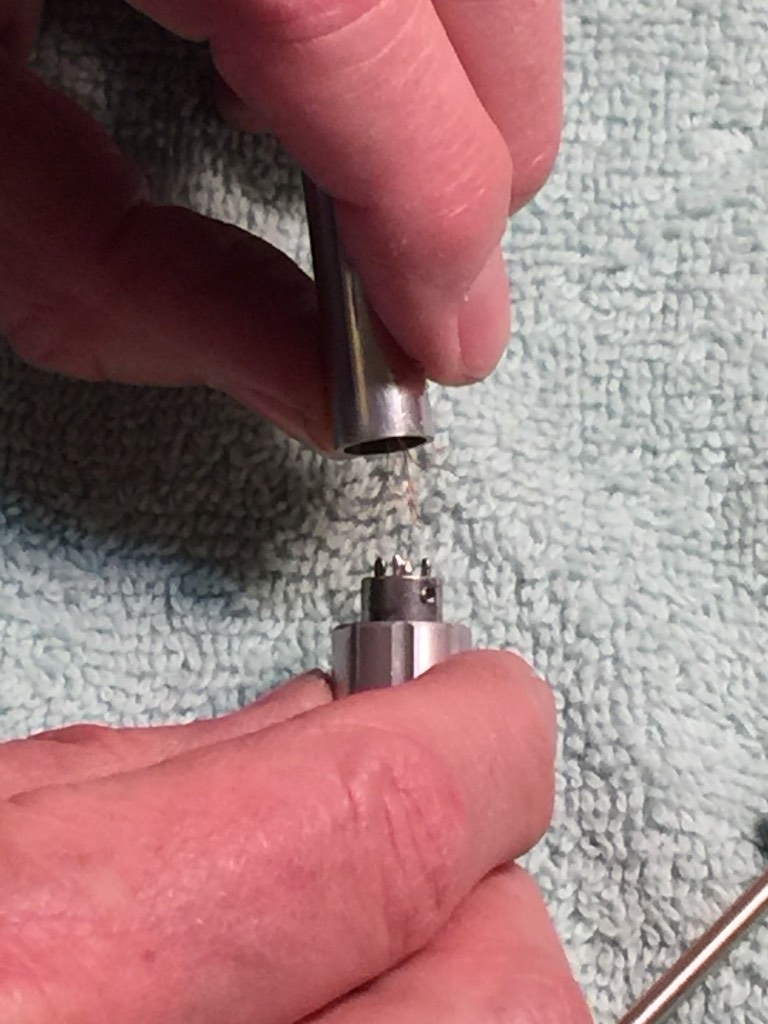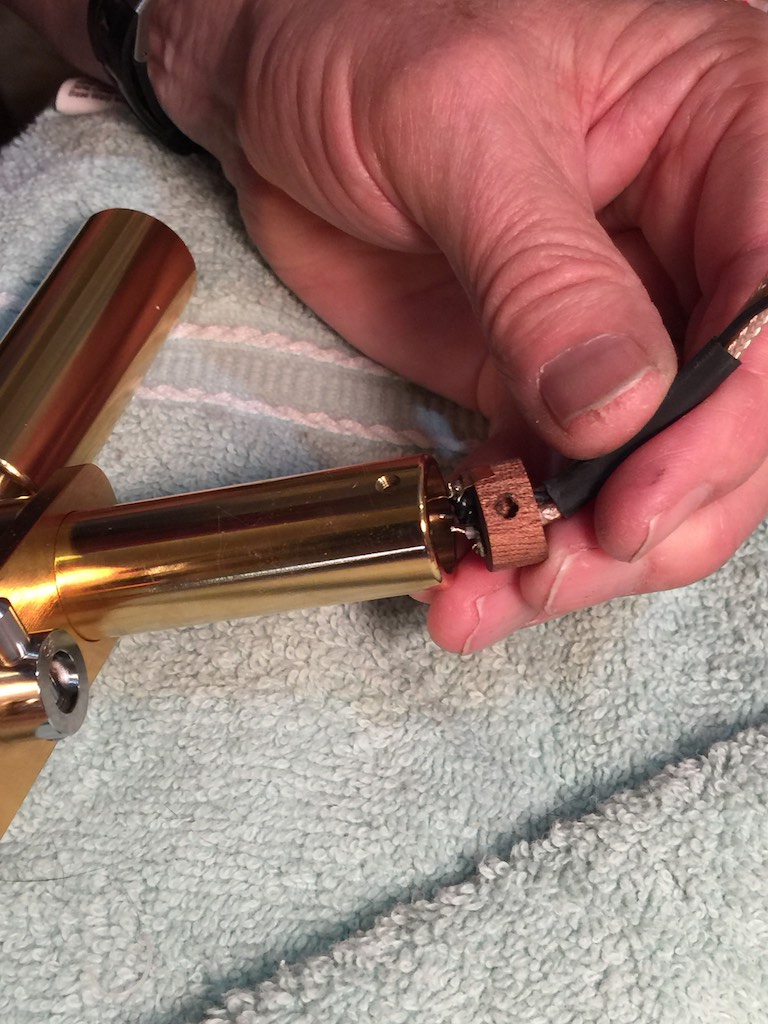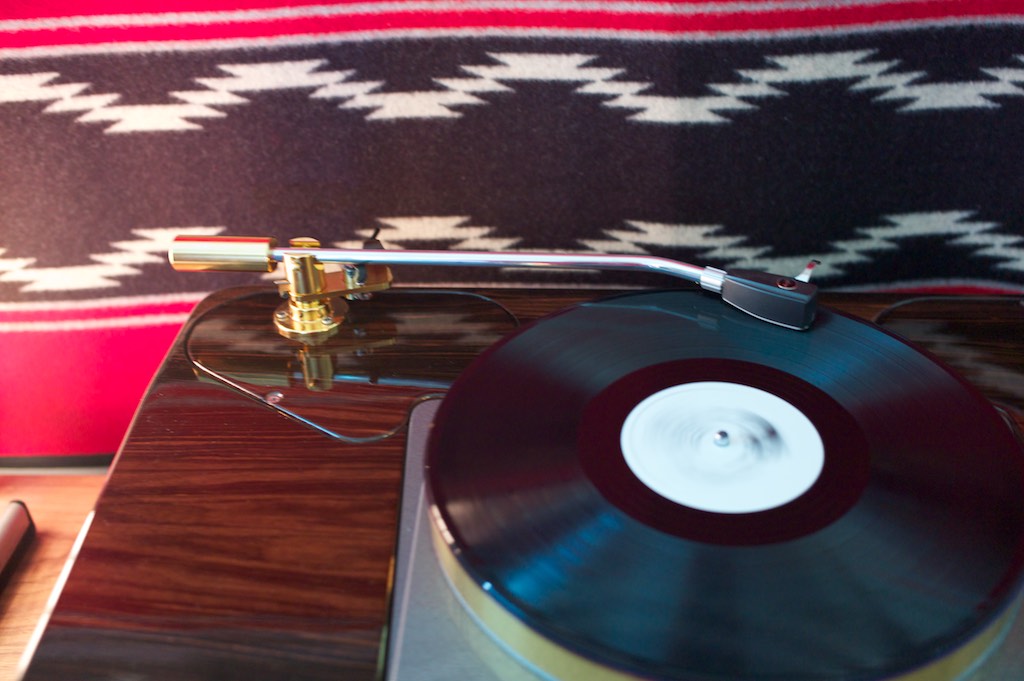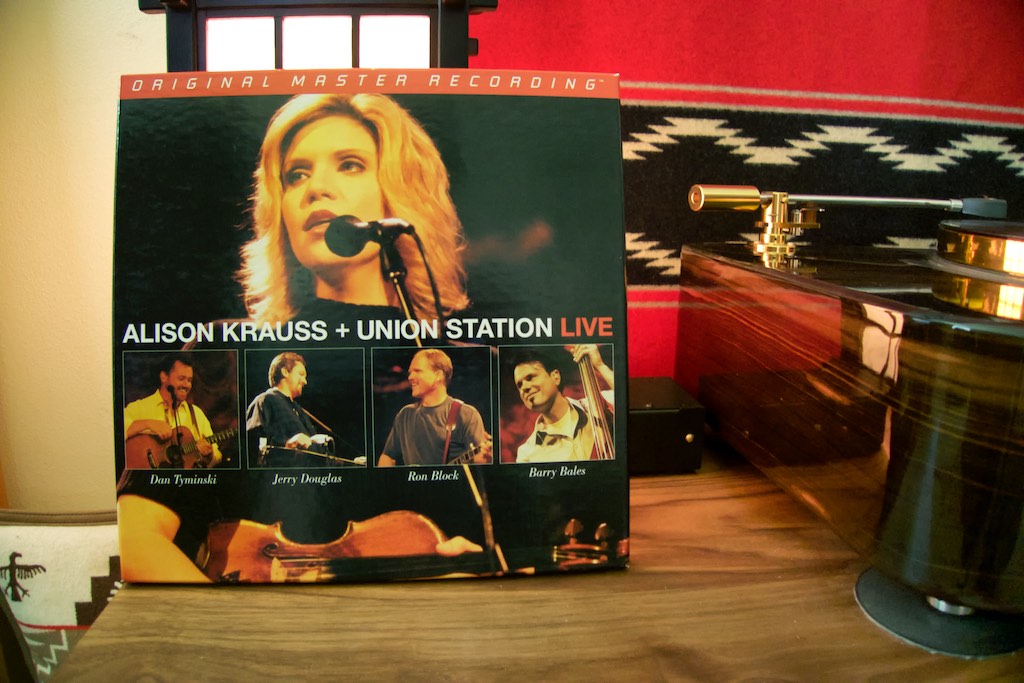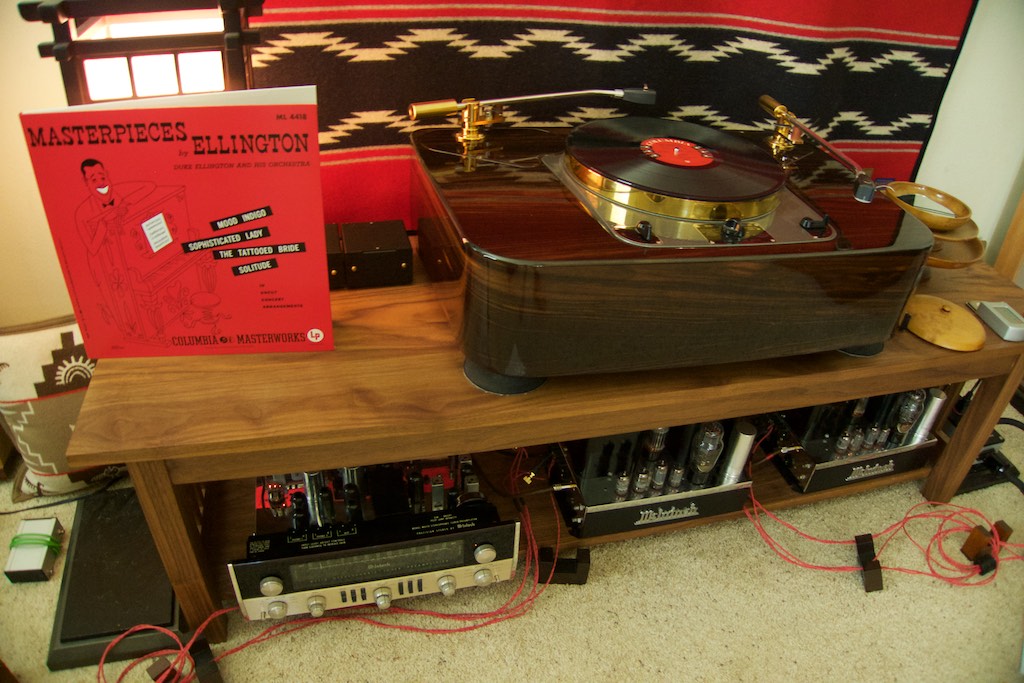If you read my post about Rafe's and Don's road trip to Jeff's Place (and Rafe's Part-Time Audiophile trip report), you know that one of the demos we did was a comparison of one of my Schick tonearms to the Woody SPU tonearm using a Ortofon SPU Classic GM Mk II stereo cartridge.
I really like my Schick tonearms. Their clean, streamlined, design and easy adjustability make them a real treat to work with, and getting them setup is as easy as one-two-three.
When I did the demo with the Schick & Woody SPU tonearms for the guys, I thought it would just be a nice benchmark comparison of Pete's prototype Woody SPU to the highly regarded Thomas Schick tonearm, which is a Stereophile Class "A" Recommended Component.
I thought it would be one of those "the Schick sounds like this," "the Woody SPU sounds like that," sort of demos, where we could discuss the relative musical & sonic merits of the two tonearms.
What I didn't expect was that when I put the Woody SPU on my 'table and played some music that it slapped down the Schick so severely that everyone in the room was shocked. The noisy room full of happy chatting music lovers went dead quiet as we listened to the result of the dramatic transformation brought about the Woody SPU.
The Woody SPU sounded ridiculously good compared to the highly regarded Schick, it wasn't even close!
In comparison to the Schick, the Woody SPU had much more room-filling presence, with a much greater sense of space, and a rich, natural, organic, and liquid presentation that was very easy to enjoy, and it portrayed female vocals more realistically & naturally.
The Woody SPU was also more convincing from a timbral and tone color perspective, having much more of a 'real sound' presentation of timbral textures and tone color distinctions.
For a while now I have been wondering what a re-wire of one of my Schick arms with an appropriate vintage Western Electric wire would sound like, after hearing how much of a difference the vintage Western Electric headshell wires made in musicality that Yazaki-san had sent me to try.
I had mentioned this to Pete, and Pete offered to re-wire one of my Schick arms, keeping my other Schick as a 'control' so we could judge the changes from a re-wire compared to Thomas' stock wiring.
I didn't have any Western Electric wire suitable to rewire the tonearm, so Pete suggested we use the same wiring scheme he does for the Woody SPU, and that way we could compare the Woody SPU to the Schick with the exact same wiring and see what kind of differences came to light, which would tell us something about what the tonearm design was contributing to the sound.
So that led to the decision to do a slick Schick Woody-Wire re-wire! What fun!
I'll tell you what, nothing is safe from modification here at Jeff's Place, and the only thing that hasn't been modified in my system at the moment is the Ortofon SPU cartridges!
I mounted the re-wired Schick on the Garrard 2015 project 'table and got it adjusted.
Would the Schick sound more like the Woody SPU with the Woody Wire re-wire? Would it sound better than the Woody SPU? Would the Schick with the Woody Wire sound worse than the stock Schick?
Schick on Schick Session
Now that I've got a little bit of playing time on the re-wired Schick, I thought that this morning I would do a little comparative listening to the re-wired Schick 12-inch tonearm and my stock Schick 12-inch tonearm to get an idea what musical & sonic differences might reveal themselves.
I put on the Mo-Fi box set of Alison Krauss + Union Station Live for a listen. Alison's vocals are cut a little hot on this album in classic Mo-Fi fashion, but overall it is a nice album of terrific music. This album is a good test for female vocals (if something's wrong you'll hear it right away), checking for the timbre of acoustic instruments, getting a sense of the large natural acoustic space at the recording venue, and that intimate interaction between the band members and the audience that is so inherent to live recordings.
The re-wired Schick sounded pretty well balanced overall, and gave a nice portrayal of tempo and melody as band cranked through Choctaw Hayride, and a good sense of drive and beat on Bright Sunny South. Guitars, fiddle, Dobro, and acoustic bass all sounded timbrally convincing, and in the range of what I would consider 'real' or 'natural' sound. Alison's vocals on The Lucky One sounded relatively natural, although on the opening song Let Me Touch You For Awhile, Alison sounded on the edge of being strident, but it might just be that Mo-Fi 'hot balance' kicking in.
When I cranked up the volume to concert-like loudness levels the slight stridency I was hearing largely disappeared, which was interesting, as usually stridency will get worse as you increase volume. Soundstage moved forward, got bigger, deeper, and wider as volume increased as well. That scores points with me, because if something doesn't sound good at near live levels then I think it diminishes the sense of musical realism, or as our dear friend Yazaki-san would say, Real Sound.
There is also a really nice expansive sense of space, good transparency, and decent resolution without sounding analytical.
So the Woody Wire re-wired Schick tonearm sounded pretty darned good in my limited listening session with Allison Krauss.
I then installed the Ortofon SPU Classic GM MkII that I was using with the re-wired Schick onto the stock Schick, and then dialed in the tracking force and azimuth. I swapped the stock Schick interconnects over and connected them to the Intact Audio SUT.
I let things warm back up for awhile, then gave Alison Krauss + Union Station Live another listen with the stock Schick tonearm.
The stock Schick also sounded pretty well balanced overall, but with subtly less emphasis on bass notes. The stock Schick gave a very good portrayal of tempo and melody as the band cranked through Choctaw Hayride, and a good sense of drive and beat on Bright Sunny South. Guitars, fiddle, Dobro, and acoustic bass all sounded relatively timbrally convincing, but a little more 'wiry' sounding than with the re-wired Schick. The stock Schick emphasizes the upper midrange more than the re-wired Schick. The stock Schick sounded a little more lively & exciting than the re-wired Schick, there was a little more percussive emphasis to picked strings, and the dynamics of the stock Schick were more pronounced (which is probably why it sounds more lively & energetic). Alison's vocals on The Lucky One and Let Me Touch You For Awhile were more strident on the stock Schick.
I liked the musical & sonic balance of the re-wired Schick better than my stock Schick, but the differences were fairly subtle. This hints that either the tonearm design plays a larger role in the overall sound than the wire does, or that the wire used by Thomas and Pete have fairly similar sonic characteristics.
A Mono on Mono Schick Session
I've noticed that when listening to my mono Ortofon CG 25 Di MkII phono cartridge instead of the Ortofon SPU Classic GM MkII cartridge, that the performance gap between the Woody SPU and the Schick narrowed considerably, and in fact favored the Schick slightly.
I have no idea why the Woody SPU tonearm plus Ortofon SPU Classic GM MkII cartridge combination was so dramatically better than the Schick tonearm plus Ortofon SPU Classic GM MkII cartridge combination, but the difference was dramatic for all those who heard it. Why the same isn't true for the mono Ortofon CG 25 Di MkII phono cartridge is a bit of a mystery, and perhaps it is just one of those happy synergy situations.
I mounted the mono Ortofon CG 25 Di MkII phono cartridge on the re-wired Schick, and put the mono Masterpieces by Ellington album on the platter for a little listening, to hear what difference in sonics & musicality there might be between the two Schick tonearms for mono playback.
The Masterpieces album is a honey of an album, and really sounds great when using the mono Ortofon CG 25 Di MkII phono cartridge to play it back.
The rewired Schick arm was right on the edge of sounding strident on the opening muted trumpets in Mood Indigo, but not over the edge, which after all is somewhat the nature of muted trumpets. Yvonne's voice on Sophisticated Lady sounded smooth, rich, and gorgeous, and Duke's piano sparkled with life. When the massed brass came in full strength in Sophisticated Lady I just about jumped out of my seat! The combination of mono Ortofon and re-wired Schick proved to be dynamic, with a good sense of tempo, and an overall tone that sounded rich and natural.
On Masterpieces the stock Schick arm with the mono Ortofon CG 25 Di MkII phono cartridge has more complex timbral textures, sounds more transparent, and has greater image presence. The muted trumpets that sounded a little to brash with the rewired Schick sounded just right with the stock Schick. Wendell Marshall's bass was more resolved, and less prominent with the stock Schick, which sounded more 'real' to me than the bass emphasis the re-wired Schick added. The overall tonality of the stock Schick arm with the mono Ortofon CG 25 Di MkII phono cartridge was really unparalleled, and the rewired Schick just couldn't match it.
With the mono Ortofon CG 25 Di MkII phono cartridge the stock Schick was clearly better both musically & sonically than the rewired Schick on Masterpieces by Ellington, so the stock Schick will stay at the top of my list for dedicated mono listening.
The rewired Schick tonearm was subtly better with the Ortofon SPU Classic GM MkII stereo phono cartridge on the Mo-Fi box set of Alison Krauss + Union Station Live than was the stock Schick, but probably not by enough to make a rewire worthwhile.
I think a rewire with some vintage Western Electric wire might yield some interesting insights. It might help answer the question, "Is the Schick tonearm relatively insensitive to different wire, or do the two wires that Thomas & Pete use sound similar?"
Pete has suggested we deconstruct some WE16GA, take the bare strands of tinned copper wire and lacquer them, then use them to rewire the armwand, and hear what happens. I like the idea (and C. J., it might help us to answer the question of what a Western Electric rewire might contribute without you parting with a bunch of WE wire, but thank you again for suggesting it).
I'm thinking I might put the re-wired Schick on the Cable Cooker for awhile and see what happens.
More to come.
Thanks for stopping by!





